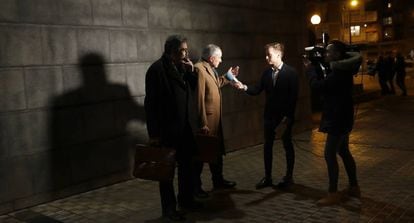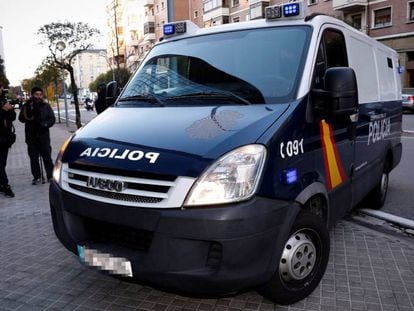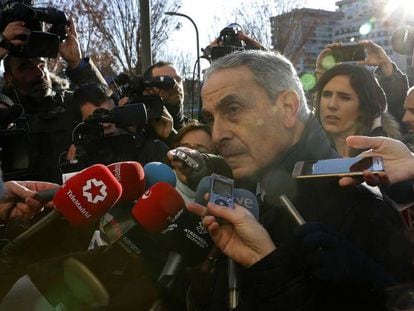La Manada: the cast of secondary characters in a trial by media
The Pamplona gang-rape trial has seen some seek out the cameras, and others try to avoid them

The “La Manada” case, as the trial of five alleged rapists has come to be known, has a large cast of secondary characters. The victim is a woman who was 18 years old at the time of the alleged assault, during the 2016 Running of the Bulls in Pamplona. La Manada – or “The Pack,” so called after the name of their WhatsApp chat group – are five men from Seville, aged between 25 and 27 at the time of the events, and who include one Civil Guard and one member of the Spanish military, both of whom have since been suspended.
Even though the trial has taken place behind closed doors, the action in the courtroom has been discussed daily in the media. The hearings concluded on Tuesday, and a verdict is due by the three judges in charge of the case.
The media circus has been relentless, with experts and non-experts alike offering their views on the case
The media circus has been relentless, with experts and non-experts alike offering their views on the case in front of the cameras. Here is a run-down of some of the individuals involved in the case.
The investigating judge. Edilberto Esteban was the first judge to take testimony from the victim, on July 8, just one day after the alleged assault. The entire case revolves around his investigation, and it was he who placed the five suspects in pre-trial custody after they refused to testify, and who classed the facts as a “gang rape.” In his written decision he underlined that the victim was “very clear in terms of the mechanics used” by La Manada, and insisted that they “forced her to enter [the doorway of a residential building] and to perform oral sex” before she was penetrated. The defense has criticized the judge for not releasing the video that were recorded by the defendants, thus making the job of the experts more difficult.
The reporting judge. Drafting the verdict will be up to José Francisco Cobo Sáenz, an experienced judge who tried a key case of gender violence in 2003: the murder of Alicia Arístegui, a woman who was killed by her abusive partner in the street. He convicted the man to 22 years in prison, and underscored the “coldness” of the defendant.
Who better than my clients to […] clean up the sexist image of a national fiesta such as Sanfermines?
Agustín Martínez Becerra, defense lawyer
A woman in the courtroom. Raquel Fernandino is the only woman on the court’s three-judge panel. She arrived at the Navarre High Court in 2015, after a decade serving in Madrid, where she handled several high-profile cases such as Google’s irregular collection of private data via its Street View cars, and two lawsuits against former Podemos politician Juan Carlos Monedero for alleged tax fraud.
The third card. Ricardo Javier González completes the panel. He was a judge in Bilbao before being transferred to Pamplona in 2001, where he has served as reporting judge in a number of sexual violence cases.
The public prosecutor. The voice of Elena Sarasate, 53, resonated beyond the courtroom this week. She used her closing arguments to reinforce the narrative she has constructed during the trial, stating that the victim was raped in a climate of “violence and intimidation.” She was a prosecutor in cases involving minors up to 2015, and has handled a number of cases involving sexual violence, such as assaults on prostitutes.
The media-hungry lawyer. Agustín Martínez Becerra decided on a defense strategy for his three clients that would involve plenty of TV appearances. “I don’t know what I’m going to do now, when I arrive in court and no one is looking at me anymore,” he admitted on Wednesday, on his way back to Seville. He has called his clients “imbeciles,” “pigs” and “dimwits” on several occasions, but insisted that they “are not rapists.” He in turn has been roundly criticized for the way he has described the attitude of the victim, alluding to the way she sat in court while giving testimony, her way of relating to other people, her tastes… All with the aim of questioning her credibility. He has also described the trial as “political.” “Who better than my clients to […] clean up the sexist image of a national fiesta such as Sanfermines?” he has asked.
The cautious counsel. Jesús Pérez is the lawyer for the Civil Guard member accused in the case. He admits never having handled a sexual assault case before. He argued that his client only recorded the incident on his cellphone, and handed over the device as evidence. He has opted for a low profile, aware that the “show trial has already taken place.” He has now threatened to have the case declared a mistrial over a violation of the presumption of innocence. “All of the reports are based on a false premise: that there was a sexual assault. As such, they are flawed.”
The discreet lawyer. Also from Seville and without experience in this kind of case, Juan Canales is defending the army member. Canales made headlines when he submitted a report by private detectives who tracked the victim after the attack. After the report triggered widespread controversy, he withdrew it from evidence after it had already been accepted by the court.
The victim’s lawyer. Carlos Bacaicoa is the court-appointed lawyer representing the victim in the case. In a grim twist of fate, he happens to live in the same apartment block where the alleged assault took place, at 5, Paulino Caballero Street. He has not spoken to the media much, apart from stating that he believes that the “case has already been won.” He only sought out the cameras to say that the 96 seconds of video recorded by the men of the sex acts was “disgusting.”
English version by Simon Hunter.












































